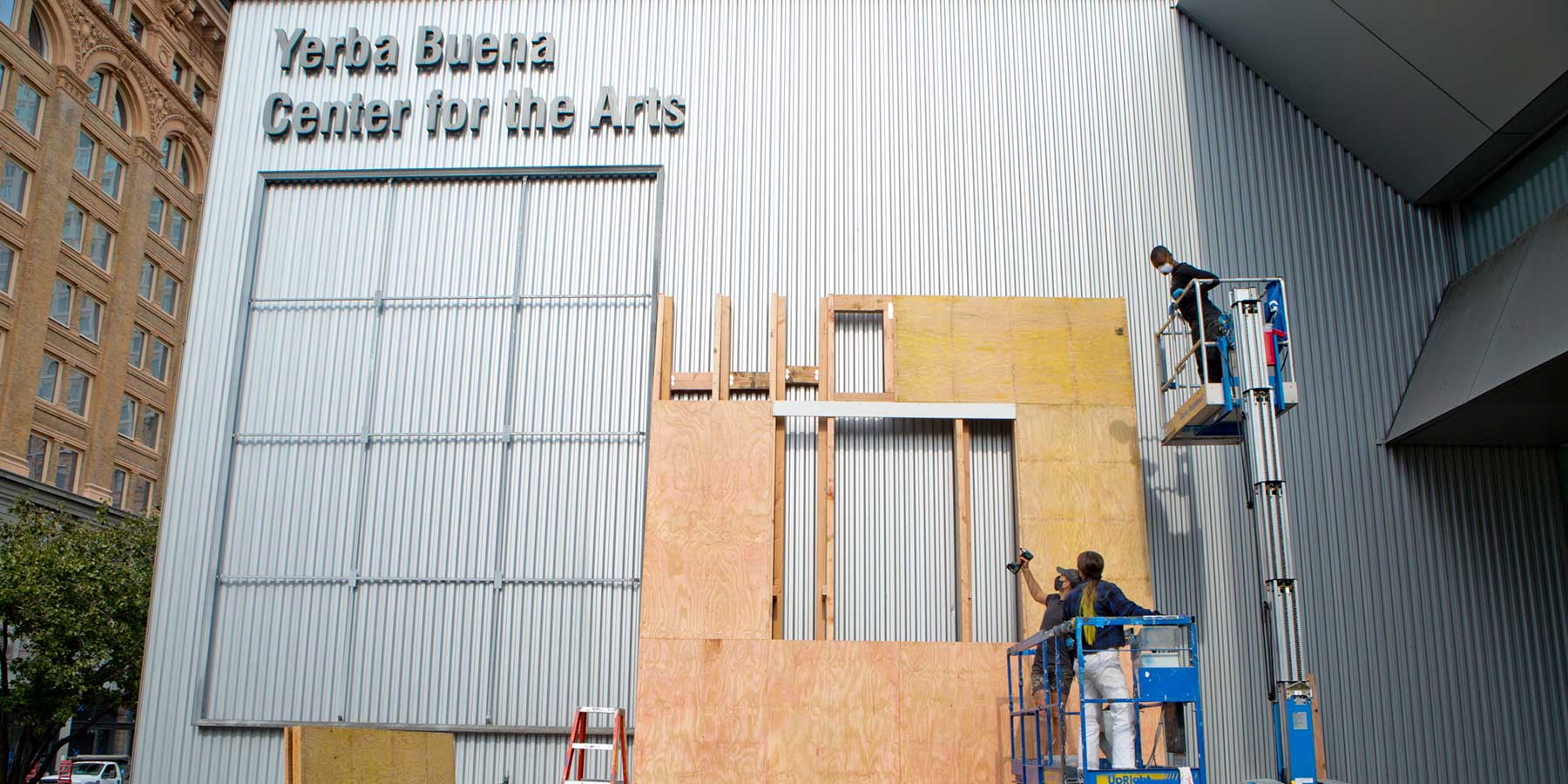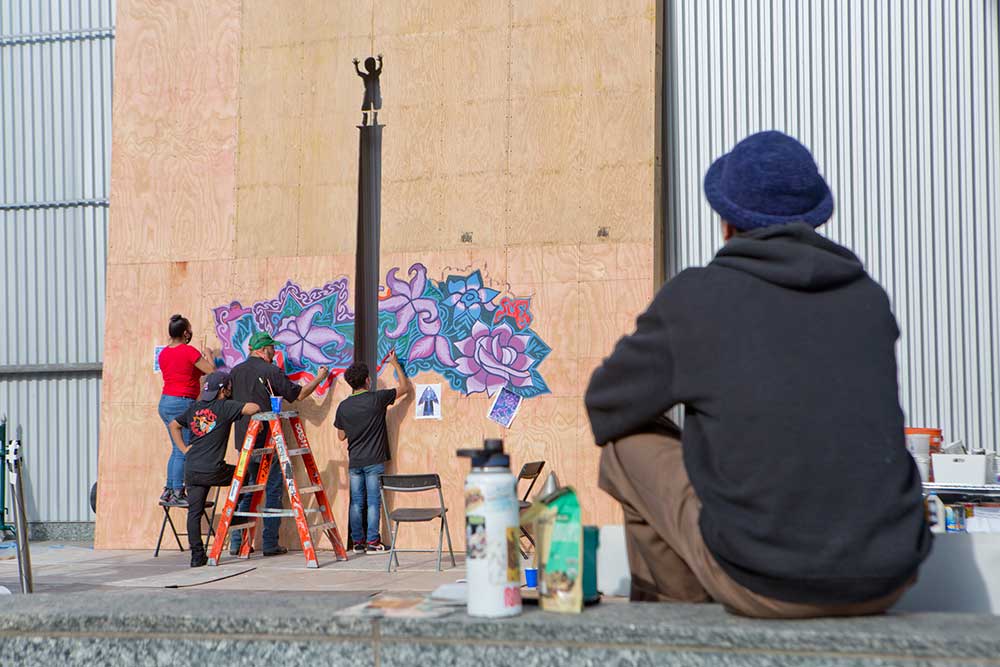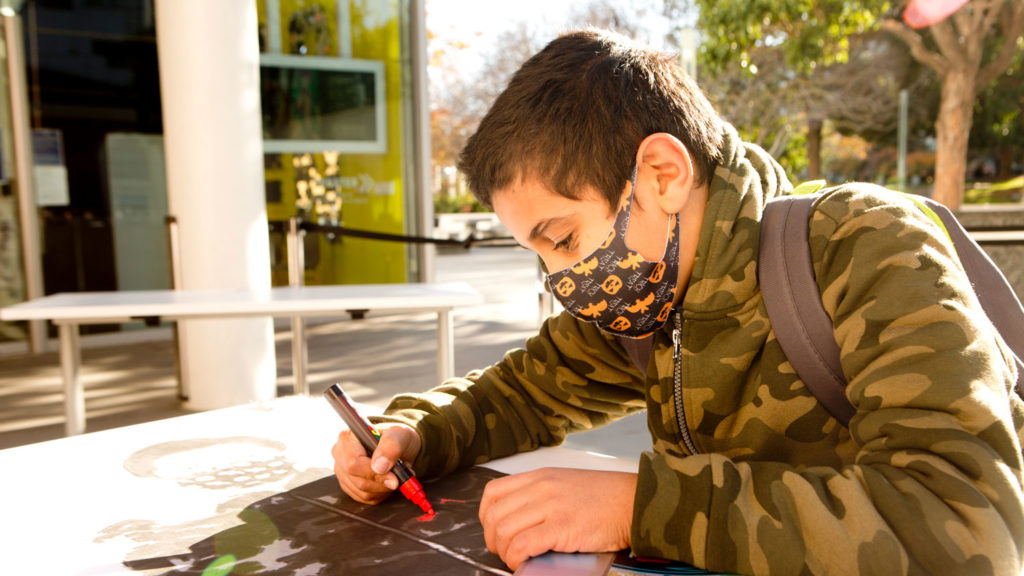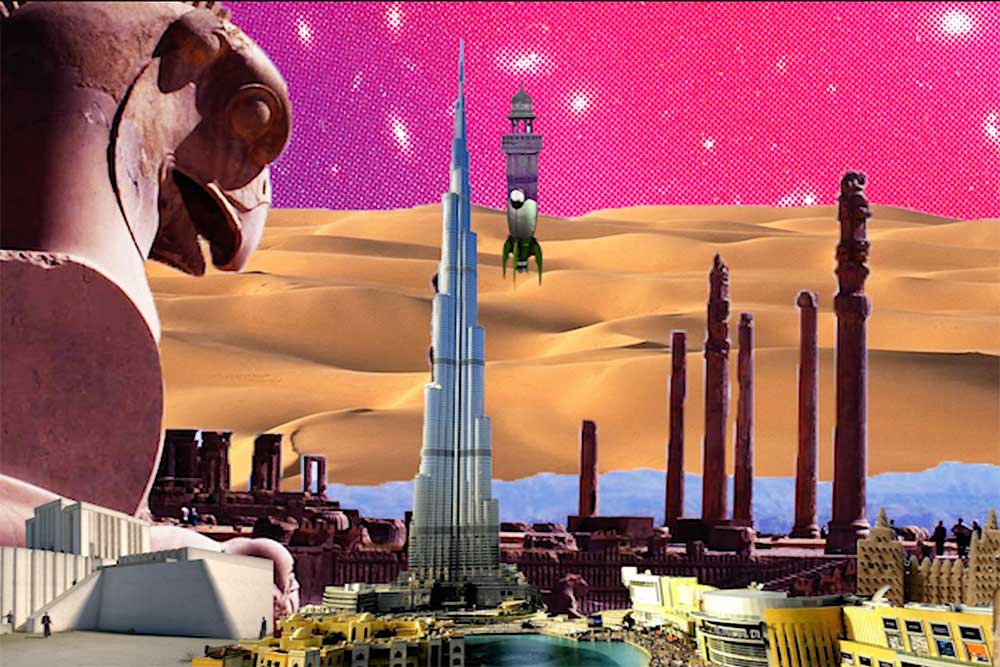Mon July 14th Closed
Unpacking the Aesthetics of Revolt with Caleb Duarte

Caleb Duarte’s new site-specific sculpture The Monument as Living Memory illustrates the closure, dismantling, and restructuring of institutions, the toppling of monuments, and the uprising of a palpable collective spirit across our country. Taking form as a larger-than-life board in the public space, this work echoes the simultaneous temporary closure of YBCA’s galleries and opening of a platform for public voice.
Working closely with Bay Area artists and collectives, this work will be an evolving collaboration over the course of 18 weeks, with new revisions, additions, and cover ups added every two weeks until Duarte’s final layer is created in mid-February.
Caleb Duarte is best known for creating temporary installations using construction type frameworks such as beds of dirt, cement, and objects suggesting basic shelter. His installations within institutional settings become sights for performance as interpretations of his community collaborations.
On Friday October 9, 2020, while installing The Monument as Living Memory on YBCA’s Plaza, Duarte sat down with Associate Director of Public Life Martin Strickland to discuss how his work captures the aesthetics of revolt, and the power of artists in reflecting and responding to our history in real time.
Martin Strickland: Originally you had been selected as the winner of YBCA’s Open Call for The Wavy Wall, which is a 30-foot-long mural space along Third Street. Between that selection and the project you’re working on installing today, a lot has changed. Can you walk me through the evolution of the work, it’s placement, and how you imagine the public might engage with it?
Caleb Duarte: The first call-out was a digital mural, which I’ve never done before. And the budget was pretty big compared to the larger community projects I’ve been engaged with. So thinking how budgets are allocated and for what kind of services, I’m thinking digital posters, you might work with larger design companies where it requires that kind of budget. I have no idea. But it was an attractive thing to go after, especially with the community engagement component that was part of the call-out, to see who could expand it into not just a digital platform, but to continue community engagement throughout the programming for that season. And so I did propose to do some community performances with that budget, distributed it to different communities, groups that we could do sculptural performances and document it, and then translate that into a mural, and then translate that into the digital poster.
I had never done a digital thing before and the placement was an interesting place as it made the project more site-specific as well. I was thinking about the workers, the folks that exist in the shadows of these huge hotels and buildings and art institutions, about that population and the visibility of the workers that exist through the back doors of the kitchens and hotels.
When I had the interview at YBCA is when the lockdown happened, that same day, that same weekend. And so everything was just put on hold for a few months. And I was like, “Okay, they’re going to shift their priorities. It’s probably going to get canceled or shelved, and use those fundings to keep certain things alive in the space.” But no, they said they were committed to seeing it through, but they just needed to figure out some things. And so I also put it on the back shelf.
And then later on, Meklit and the Programs team started thinking about other ways to realize this thing and suggested the front billboard. That’s when the Bay Area was protesting the murder of George Floyd, the COVID-19 lockdown and the uprisings were happening at the same time. I wanted to look at how we do our best with the resources that we have, the language that’s emerging, the urgency of artists’ response, to be responsive to the times as artists? And so that’s where this new proposal came about.
“The urgency of the boarded up windows, and then the permanency of a monument together might be an interesting juxtaposition to think about where culture is created, where truth is created.”
MS: And can you tell me a little bit about what the new artwork is?
CD: The new site is the front of YBCA, where there is normally a posted billboard that’s there to promote the events or the identity of the institution. I’m told that it’s never been taken down before. And so the proposal was to mimic the size of that billboard in a more current use of materials that we’re seeing buildings being decorated with, with the plywood protecting their windows, protecting their entrances. It’s a plywood wall with a cutout of a monument, a silhouette of a monument, to reference the shadow of something that we refuse to see. Through the shadow, we accept it a little bit better. We’re not ready to see the full reality of something. And so the shadow of the cutout is a reflection of that, of the transformation society might be going through right now, and confronting itself and its myths and its creation.
It’s not as direct as the toppling of monuments, but it’s kind of a psychological, spiritual self-reflection of the possibilities of how we can shift this moment in time into a positive direction. So we can actually see for ourselves what our history is really about.
MS: So within the work there’s two towering symbols, really of 2020, which are the abandoned, urban buildings and monuments. And both of them play a huge role in the aesthetics of this work. How do these symbols talk to one another in this work? And when they’re brought together, what do they help create in relationship to your collaborators?
CD: Well, we see that the monument is a solid, permanent, almost violent object that protrudes from the floor up. And so it tells us who we should remember, what should we remember, what our value system should be. It’s usually excluding a huge part of the population through imperialism and colonization. And then the aesthetics of revolt, which is like the dismantling of the value systems that a society holds. It seems now that that value system is consumerism, it’s corporations. When a society is outraged by the broken windows or the looting more than a human life, then that’s the exposure of our value system as a nation. So putting those together, I think, creates an interesting parallel. The urgency of the boarded up windows, and then the permanency of a monument together might be an interesting juxtaposition to think about where culture is created, where truth is created. From the bottom up or from the top down?
MS: When we have been talking about this work, as we were having conversations about how it can come to fruition and what it should be, you were describing it as an architectural intervention. And I’m wondering, can you talk a little bit more about what you mean by an architectural intervention like this site-specific one? And how can these interventions, which are really prevalent in your work, help articulate the aesthetics of revolt and resistance? That can be revolt and resistance of the moment, but also those two things span space and time in a very meaningful way.
CD: Just like the monuments, I think architecture tries to establish a certain truth and value system for that given moment in time. This intervention comes from the urgency of that time, from the business owners to the corporate owners of these large chains boarding up their spaces, also the identity of this place, of this neighborhood, Yerba Buena Gardens and the construction that’s happening all around. That’s the kind of intervention where small additions to a building changes its identity drastically, or it changes its sense of truth that architecture tries to establish.
So sometimes architecture, it’s epic in the way we understand ourselves. It was one of the most powerful ways to establish a sense of truth in any given society. Visiting the Vatican, you practically convert right away, because it’s just so amazing. Thinking about the skyscrapers, the symbolism between the Twin Towers in New York. Every little town has its sense of identity through its architectural forms. To shift that and challenge the status quo through a simple use of plywood structure, I think it’s pretty powerful. It shows that cultural shifts often come from the masses, not from individualism, and it comes from the bottom up. I think that’s the aesthetics that we’re working with right now.
MS: So with this project, you’re working with a number of collaborators in the Bay Area. The way that this is set up is that you’re able to respond to the moment and to give a voice to different communities, or allow their voice to come through. What’s really exciting is we don’t really know who’s going to be contributing to this project yet, meaning we don’t have the roster of every collaborator set on what week, but that’s really the point. Can you talk a little bit about why you see it important to enter into a project without an articulated end? What do you think we can learn from this approach as viewers, either through a digital space or a physical space, by watching it evolve over the next couple of months?
CD: I think one of the main things that artists or cultural makers aspire to is the sense of authenticity, and that authenticity doesn’t come through just aesthetics itself. I think, rather, it comes through everything around aesthetics. What’s happening in politics? What’s happening in larger society outside of your studio? Are you responding to the times? And that kind of authenticity is really outside of the recipes that we know how to use as artists or cultural makers. And so as artists, we’re more paying attention to how culture is manifested outside of an isolated creative process. And that is always through the people, and how people organize, how people move, how people are driven to the point of frustration and revolt against our laws and our systems. Artists are ready to respond right away to that authenticity. We’re not particularly interested in the idea of this celebrated individualism that is well-known through art schools and stuff like that. So to keep that flexibility, to have artists respond within a two week notice, I think it’s really important to see if that authenticity can rise up to the call.
Art institutions are somewhat slow in catching how culture shifts. I think corporations are much faster in figuring out how to sell and advertise culture. Art institutions catch it later on, when it’s already a little bit more packaged and articulated in a way that’s familiar to art historians or art critics. That’s what we’re trying to resist. We’re trying to avoid that time lapse of cultural validation, so that policy is made, so that culture shifts, so that the masses are heard on a mainstream level.
Now we see white supremacy and racism reach the mainstream, and I think white America is finally shocked that it’s actually mainstream. They’re participating in the conversation. They’re participating in the marches. They’re participating in policy change. They’re looking within themselves because I think they’re super surprised that this is actually a mainstream movement and conversation about white supremacy that communities of colors have always felt and endured through laws, through policies, through mass incarceration. Now is the moment to think, is poverty a consequence of this mythology of white supremacy? Is time to really reflect upon ourselves and our own history, to really acknowledge this violent harm? That’s the kind of authenticity I think that we’re trying to look for when we participate in cultural making.

MS: And the final question is, as we begin to see art institutions opening back up after months of forced closure due to COVID, there are a lot of conversations around what we should expect of them. And I think that this hearkens back to what you were just talking about in your last answer, which is how quickly they catch up to what is happening in the moment. So what should we expect of them that we might not have expected six months ago, a year ago? And in a way, how can this help contribute to an ongoing dialogue of finding and supporting new spaces for public voices?
CD: Well, that’s the thing. We’re going to see a lot of programming shift from the Whitney Museum to new reporters, new voices for stations like NPR. We’re hearing more journalism that’s coming from different points of view, different perspectives. All that is a beautiful cultural shift. We would hope that it’s not part of a way for organizations, institutions to feel safe within the times, to feel protected by saying we’re making these important changes. Instead, we hope for real self-reflection for a long-term shift. When we’re talking about aesthetics, we’re also talking about different forms of knowledge, different points of view, different perspectives. When I say different forms of knowledge, I’m not talking about made-up facts like what we’re seeing. We’re talking about other ways of understanding happiness, other ways of understanding progress, prosperity. That it does not come from a specific lens that’s been the white narrative in our institutions where the rest of the marginalized communities have to abide by, to mourn our dead from our rituals. And it’s not just the white myth, it’s capitalism, it’s the structure behind capitalism, how violent it is.
So, hopefully it doesn’t seem like it’s the flavor of the month where we’re being patronized, or we’re not being used as a form to soften up the hard work that it takes. You may be with your family and need to have that talk, have that intervention with a loved one. It’s time for our whole nation to have these conversations. Hopefully, artists of color that have been doing this work or marginalized artists aren’t being used to soften that harsh talk that has to happen within institutions. It should happen within those institutional structures, and without using this moment to engage with artists as a means of easing the way through the hard cultural shifts that’s happening.
All images courtesy YBCA and Tommy Lau.



